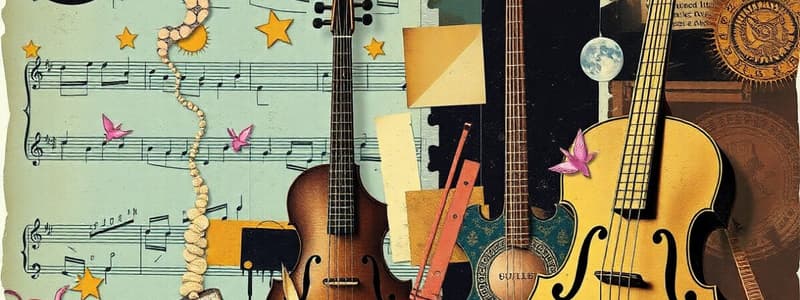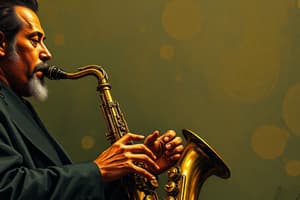Podcast
Questions and Answers
Which of the following instruments are positioned at the back of the orchestra?
Which of the following instruments are positioned at the back of the orchestra?
- Bassoons and Oboes
- Violas and Cellos
- Trumpets and Trombones (correct)
- Piccolo and Xylophone
A musician wants to play the lowest note possible in the brass section. Which instrument should they choose?
A musician wants to play the lowest note possible in the brass section. Which instrument should they choose?
- Trumpet
- Trombone
- Tuba (correct)
- Bass Trombone
Which instrument family produces sound by vibrating air down a tube?
Which instrument family produces sound by vibrating air down a tube?
- Brass
- Percussion
- String
- Woodwind (correct)
Which of the following is an example of an untuned percussion instrument?
Which of the following is an example of an untuned percussion instrument?
Which instrument is known for its ticking rhythm in Haydn's Symphony No. 101?
Which instrument is known for its ticking rhythm in Haydn's Symphony No. 101?
How are the musicians typically arranged in a symphony orchestra?
How are the musicians typically arranged in a symphony orchestra?
If an instrument is NOT mentioned in the seating arrangement provided, where would you most likely find information about it?
If an instrument is NOT mentioned in the seating arrangement provided, where would you most likely find information about it?
Flashcards
Seating Arrangements
Seating Arrangements
Players are arranged in a semicircle facing the conductor, balancing louder and quieter instruments.
Percussion Instruments
Percussion Instruments
Instruments that create sound through being hit or shaken, often untuned and not featuring fixed pitches.
Brass Instruments
Brass Instruments
Long metal tubes that produce sound by buzzing lips; includes trumpet, trombone, and tuba.
Woodwind Instruments
Woodwind Instruments
Signup and view all the flashcards
Xylophone
Xylophone
Signup and view all the flashcards
Timpani
Timpani
Signup and view all the flashcards
Haydn's Symphony No. 101
Haydn's Symphony No. 101
Signup and view all the flashcards
Study Notes
Seating Arrangements in an Orchestra
- Players are seated in a semicircle, facing the conductor.
- Louder instruments are positioned behind quieter ones, to balance sound.
Percussion Instruments
- Percussion instruments produce sound by hitting or shaking.
- Many are untuned, meaning they don't have fixed pitches.
- Examples include xylophone, timpani.
Brass Instruments
- Brass instruments are long metal tubes, coiled in different shapes.
- Trumpet produces high notes.
- Trombones and horns produce middle notes.
- Tuba produces low notes.
Woodwind Instruments
- Woodwinds produce sound by vibrating air in a tube.
- The instruments have a wide range of sounds.
- Examples include piccolo, oboes, English horn, contra bassoon.
Additional Information
- Haydn's Symphony No. 101 ("The Clock") is mentioned as an example piece for listening.
Studying That Suits You
Use AI to generate personalized quizzes and flashcards to suit your learning preferences.





